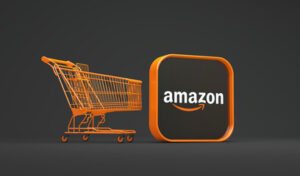
This year’s holiday shopping season kickoff brings earlier promotions, as retail competitors push deals to win over budget-conscious shoppers before peak November spending.
The fourth quarter is the Super Bowl for retail, a period that accounted for over $1.88 billion in sales last year.
But this year, the competition is fiercer than ever. Major retail competitors are all launching massive sales events in early October, fighting for a piece of a market where consumers plan to spend less.
This aggressive kickoff sets a new, high-stakes tone for the holiday shopping season, and understanding the battleground is essential for survival.
Amazon Leads the Charge with Prime Big Deal Days
Trae Bodge, the shopping expert at TrueTrae.com"Sale moments like this (Amazon Prime Big Deal Days) are more important than ever for consumers on a budget."
Amazon announced it is officially kicking off the holiday shopping season with its Prime Big Deal Days event. The sale begins on October 7
Amazon's Two-Day Event with Added Perks
According to an article on EMARKETER by Zak Stambor, Amazon’s confirmed two-day sale event for its Prime Big Deal Days is a significant shift from the company’s four-day Prime Day sale in July.
The shorter duration is part of a broader holiday strategy to kick off the season early without overshadowing the critical Cyber Five period. This approach considers the industry trend of extending holiday sales, which created a “Cyber Dozen” last year.
Analysis suggests three key factors explain the decision for a condensed event. The primary reasons include managing news headlines, reducing seller strain, and better holiday pacing.
First, a shorter sale helps avoid the risk of negative headlines. The longer July event was impacted by early reports of slow spending, which detracted from its overall success.
Second, the two-day format eases the burden on sellers who face pressure from tariffs and rising costs. Extended promotions can erode seller margins and make it difficult to sustain discounts throughout the entire season.
Finally, the event’s timing is designed for a compressed holiday sprint. With only 28 days between Thanksgiving and Christmas, a shorter sale helps pace promotions effectively.
To boost participation, Amazon is also offering Prime members a range of additional benefits. These perks are designed to drive spending and encourage new sign-ups.
- Entertainment Access – Members get early access to exclusive screenings of the movie “Wicked: For Good” on November 17 and can shop for limited-edition merchandise.
- Fuel Savings – A partnership with bp’s loyalty program provides $1 off per gallon on a single fuel purchase, plus 10 cents off daily.
- Food Offers – Members can use their free Grubhub+ subscription to get a free 10-piece Chicken McNuggets Meal once a day between September 15 and October 5.
- Credit Card Rewards – Prime Visa cardholders can earn 10% back on select brands like Dyson and Breville and 7% back when choosing No-Rush Delivery.
Walmart Counters with Six-Day 'Walmart Deals' Event
According to Zacks Equity Research, Walmart is setting a competitive pace with its own promotional push called “Walmart Deals.” The six-day event runs from October 7 to October 12, giving shoppers an early chance to capture major savings before the holiday rush.
The sale spans a wide range of product categories. Shoppers will find discounts on items from toys and fashion to home goods and seasonal decor.
Customers can shop the event online, through the Walmart app, or in stores. The company is offering flexible fulfillment, with delivery options ranging from early morning drop-offs to express service in as little as 30 minutes.
While the event is open to all, Walmart+ subscribers get a five-hour head start on October 6 to secure the most sought-after deals. Discounts are expected to reach as high as 50% on a mix of exclusive products, private-label items, and national brands.
The timing aligns with the growing trend of consumers starting holiday shopping in October to manage their budgets. To assist shoppers, Walmart is also offering digital support through “Sparky,” its AI-powered assistant for gift ideas and product comparisons.
This event is part of a broader strategy to reinforce Walmart’s position as a year-round savings destination, complementing its 6,000 ongoing rollbacks. The early holiday push is a strategic effort to capture consumer spending at the start of the season and sharpen its edge over competitors.
Membership and Delivery Emerge as Key Battlegrounds
In an article on Fortune, by Retail Brew, a key difference in strategy has emerged among the major retailers, with Walmart promoting its sales event as open to all customers. This approach stands in contrast to its primary competitors, who are making their top deals exclusive to members.
While Walmart+ members receive a five-hour head start, the company emphasizes that no membership is required for its main “Walmart Deals” event. Other retailers are taking a different approach to their October sales.
- Walmart – Deals are open to all customers.
- Amazon – The Prime Big Deal Days event is “member-exclusive.”
Despite Walmart’s open-to-all messaging, its membership programs are proving successful. The company’s membership income grew 15% in the second quarter, while Target also reported double-digit growth in its membership revenue.
Amazon Prime membership also continues to show steady growth. However, this growth faces scrutiny from the Federal Trade Commission, which alleges the company enrolled millions of customers into the program without their consent.
Beyond membership strategies, a consistent focus for all three retail giants is the promise of faster delivery. Each company is highlighting its rapid fulfillment capabilities to attract shoppers.
- Amazon – Offers Prime members free same-day or one-day delivery on more than 300 million items.
- Walmart – Touts the availability of same-day, early morning, and express delivery options for all its customers.
More Retailers Join the October Sales Fray
In her EMARKETER report, Rachel Wolff wrote that the competitive landscape extends well beyond Amazon and Walmart, with several other major retailers launching their own sales events. These promotions are strategically timed to capture early holiday spending and compete directly with other October deals.
Target is bringing back its Target Circle Week, which will run from October 5 to October 11. The event promises deeper discounts for members of its free loyalty program as well as for its paid Target Circle 360 subscribers.
Best Buy is hosting a “Techtober Sale” from October 6 to October 12 for the general public. This sale follows an exclusive access period for its loyalty program members that began on September 28.
Kohl’s will run its Cyber Deals event from October 6 to October 9, making it one day longer than last year’s promotion. Shoppers can find discounts of up to 50% on items available both in-store and online.
Cautious Consumers Redefine Holiday Spending Landscape
This year’s holiday sales events are different from last year, as illustrated by the findings of a PWC survey, which describe the season as less predictable and more improvisational. The 2025 Holiday Outlook survey projects an average 5% decline in consumer holiday spending, marking the first notable drop since 2020.
Concerns over rising prices, new tariffs, and the higher cost of living are driving this cautious behavior. The biggest adjustment is expected in gift spending, which is projected to fall by 11%, while budgets for travel and entertainment remain stable.
A deeper analysis of the data reveals a significant generational divide in spending intentions. Gen Z consumers are expected to slash their holiday budgets by 23%, while millennials plan to hold steady and baby boomers intend to increase their spending by 5%.
This sharp reversal for Gen Z is attributed to a tougher job market and rising fixed costs. Despite budget cuts, this group prioritizes sustainability and wellness, with 63% saying they will opt for resale or upcycled products this season.
Family structure is another key factor, as households with children under 18 are projected to spend more than double those without ($2,349 vs. $1,089). For the first time, holiday shopping is also nearing channel parity, with 53% of consumers planning to shop in-person and 51% using online marketplaces.
5 Strategies to Win in a Cautious Market
Navigating this complex and segmented market requires a precise and adaptive strategy. For many brands, partnering with a specialized Amazon agency can provide the expertise needed to implement these targeted approaches effectively.
- Segment Your Audience
Move beyond one-size-fits-all promotions. Tailor marketing messages for different generations, such as value-focused campaigns for Gen Z and premium gift sets for Boomers.
- Emphasize Value Beyond Price
Since 78% of shoppers are seeking less expensive alternatives, highlight product durability, multi-functionality, or long-term value. Offer product bundles or “gift with purchase” deals instead of just deep discounts.
- Cater to Gen Z Values
If targeting younger shoppers, showcase your brand’s commitment to sustainability in your product listings and ads. Highlight eco-friendly materials, ethical sourcing, or wellness benefits.
- Optimize for a Tighter Calendar
With nearly 80% of gift budgets expected to be spent by the end of Cyber Monday, concentrate your advertising and promotions in the pre-Thanksgiving and Cyber Five periods.
- Offer Flexible Fulfillment and Payment
Highlight reliable home delivery options, as this remains the preferred fulfillment method for 70% of shoppers. Additionally, support a variety of payment options, including credit cards and digital wallets like PayPal, to meet diverse consumer preferences.
Emily Reasor, McKinsey Senior Partner"People are planning to spend roughly the same dollar amount as they have in the past, but they’re going to shift their spending toward needed goods as opposed to discretionary goods."






